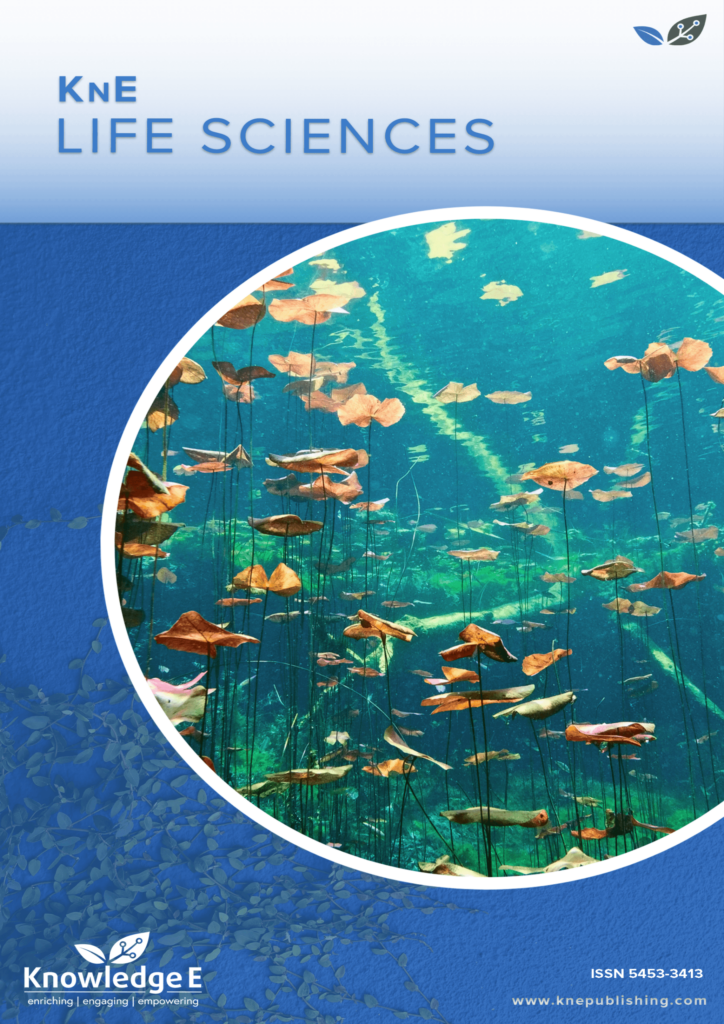
KnE Life Sciences
ISSN: 2413-0877
The latest conference proceedings on life sciences, medicine and pharmacology.
Potential Lutein Extract of Broccoli (Brassica oleracea L. var. italica) as Antiradical Abts (2,2 - Azinobis Acid, 3-Ethyl Benzothiazoline-6-Sulfonic Acid)
Published date:Jul 11 2017
Journal Title: KnE Life Sciences
Issue title: The 4th International Conference on Biological Science (2015)
Pages:125-135
Authors:
Abstract:
Broccoli (Brassica oleracea L. var. italica) is one vegetable that is often consumed by people with high nutrient content i.e protein, fat, vitamin C, fiber, potassium and calcium. Carotenoids and glutathione are contained in broccoli that are antioxidants. Lutein is a carotenoid group contained in broccoli is capable of reducing the accumulated products of free radicals in the body. The purpose of this research is to extract and identify compounds lutein from flowers of broccoli and test its potential as antiradical to the compound ABTS (2,2-Azinobis acid, 3-ethyl benzatiazolin-6-Sulfonat). Identification of lutein compounds qualitatively by TLC showed Rf value of 0.72 cm. Analysis of Lutein by HPLC showed a peak at the retention time of 3:03 min, approaching retention time of lutein standard 3:01 min. Test of potency of antiradical ABTS showed that lutein extract from flower of broccoli has antioxidant activity with IC50 value of 157.527 8 µg · mL–1. Fractionation of lutein extract using column chromatography with Silica gel 60 as stationary phase and mixture of methanol : chloroform : n-hexane (4:20:8) as mobile phase resulted in 4 fractions with antioxidant activity increased. Fraction 3 has the highest antiradical ABTS activity with IC50 39.584 2 µg · mL–1. Vitamin E is used as a standard had antiradical ABTS activity IC50 5.303 6 µg · mL–1.
Keywords: ABTS ; anti-radical; Broccoli (Brassica oleracea L. var. italica); lutein.
References:
[1] F. Khachik and G. R. Beecher, “Application of a C-45-β-carotene as an internal standard for the quantification of carotenoids in yellow/orange vegetables by liquid chromatography,” Journal of Agricultural and Food Chemistry, vol. 35, no. 5, pp. 732– 738, 1987.
[2] A. R. Mangels, J. M. Holden, G. R. Beecher, M. R. Forman, and E. Lanza, “Erratum: Carotenoid content of fruits and vegetables: An evaluation of analytic data ( J Am Diet Assoc (1993) 93 (284-296)),” Journal of the American Dietetic Association, vol. 93, no. 5, p. 527, 1993.
[3] T. Byers and G. Perry, “Dietary carotenes, vitamin C, and vitamin E as protective antioxidants in human cancers,” Annual Review of Nutrition, vol. 12, pp. 139–159,1992.
[4] D. T. H. Verhoeven, R. A. Goldbohm, G. Van Poppel, H. Verhagen, and P. A. Van Den Brandt, “Epidemiological studies on Brassica vegetables and cancer risk,” Cancer Epidemiology Biomarkers and Prevention, vol. 5, no. 9, pp. 733–748, 1996.
[5] A. Podsedek, “Natural antioxidants and antioxidant capacity of Brassica vegetables: A review,” LWT - Food Science and Technology, vol. 40, no. 1, pp. 1–11, 2007.
[6] M. M. Calvo, “Lutein: A valuable ingredient of fruit and vegetables,” Critical Reviews in Food Science and Nutrition, vol. 45, no. 7-8, pp. 671–696, 2005.
[7] G. J. Handelman, E. A. Dratz, C. C. Reay, and F. J. G. M. Van Kuijk, “Carotenoids in the human macula and whole retina,” Investigative Ophthalmology and Visual Science, vol. 29, no. 6, pp. 850–855, 1988.
[8] A. Alves-Rodrigues and A. Shao, “The science behind lutein,” Toxicology Letters, vol. 150, no. 1, pp. 57–83, 2004.
[9] N. Vyas, M. Tailang, N. P. Gavatia, and B. K. Gupta, “Antioxidant potential of Psidium Guajava linn,” International Journal of PharmTech Research, vol. 2, no. 1, pp. 417–419, 2010.
[10] M. B. Arnao, “Some methodological problems in the determination of antioxidant activity using chromogen radicals: A practical case,” Trends in Food Science and Technology, vol. 11, no. 11, pp. 419–421, 2001.
[11] JB. Harborne, Phytochemical methods. A guide to modern techniques of plant analysis, Chapman and Hall, London, 1973.
[12] DL. Madhavi and DI. Kagan, “Process for the isolation of mixed carotenoids from plants,” United States Pantent Documents, pp. 1–6, 2002.
[13] H. Manda, BK. Rao, GN. Yashwant Kutty, and SK. Swarnkar, “Swarnkar SK. Antioxidant, anti-inflammatory and antipyretic activities of ethyl acetate fraction of ethanolic extract of Schrebera swietenioides Roxb. root,” Int J Toxicol Pharmacol Res, vol. 1, pp. 7–11, 2009.
[14] N. Balasundram, T. Y. Ai, R. Sambanthamurthi, K. Sundram, and S. Samman, “Antioxidant properties of palm fruit extracts,” Asia Pacific Journal of Clinical Nutrition, vol. 14, no. 4, pp. 319–324, 2005.
[15] T. De Bruyne, L. Pieters, H. Deelstra, and A. Vlietinck, “Condensed vegetable tannins: Biodiversity in structure and biological activities,” Biochemical Systematics and Ecology, vol. 27, no. 4, pp. 445–459, 1999.
[16] A. H. Khalil and T. A. El-Adawy, “Isolation, identification and toxicity of saponin from
different legumes,” Food Chemistry, vol. 50, no. 2, pp. 197–201, 1994.